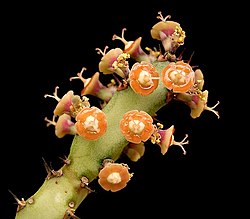Euphorbiaceae
| Euphorbiaceae | |
|---|---|

| |
| Parts of the candlenut tree (Aleurites moluccana) | |
| Scientific classification | |
| Kingdom: | |
| (unranked): | |
| (unranked): | |
| (unranked): | |
| Order: | |
| Family: | Euphorbiaceae |
| Subfamilies | |
Euphorbiaceae, the spurge family, in common English sometimes called "euphorbias",[2] which is also the name of a genus in the family, is a large family of flowering plants with about 300 genera and 7,500 species.[citation needed] Most[citation needed] spurges are herbs, but some, especially in the tropics, are shrubs or trees. Some are succulent and resemble cacti because of convergent evolution.[citation needed] Laypersons may refer to euphorbias having a growth form and succulence similar to cacti as being "cactuses".[citation needed]
This family occurs mainly in the tropics, with the majority of the species in the Indo-Malayan region and tropical America a good second. A large variety occurs in tropical Africa, but they are not as abundant or varied as in the two other tropical regions. However, Euphorbia also has many species in nontropical areas such as the Mediterranean Basin, the Middle East, South Africa, and southern USA.
The leaves are alternate, seldom opposite, with stipules. They are mainly simple, but where compound, are always palmate, never pinnate. Stipules may be reduced to hairs, glands, or spines, or in succulent species are sometimes absent.
The plants can be monoecious or dioecious. The radially symmetrical flowers are unisexual, with the male and female flowers usually on the same plant. As can be expected from such a large family, there is a wide variety in the structure of the flowers. The stamens (the male organs) number from one to 10 (or even more). The female flowers are hypogynous, that is, with superior ovaries.

The genera in tribe Euphorbieae, subtribe Euphorbiinae (Euphorbia and close relatives) show a highly specialized form of pseudanthium ("false flower" made up of several true flowers) called a cyathium. This is usually a small, cup-like involucre consisting of fused-together bracts and peripheral nectary glands, surrounding a ring of male flowers, each a single stamen. In the middle of the cyathium stands a female flower: a single pistil with branched stigmas. This whole arrangement resembles a single flower.
The fruit is usually a schizocarp, but sometimes a drupe. A typical schizocarp is the regma, a capsular fruit with three or more cells, each of which splits open at maturity into separate parts and then breaks away explosively, scattering the small seeds.
The family contains a large variety of phytotoxins (toxic substances produced by plants), mainly diterpene esters, alkaloids, glycosides, and ricin-type toxins.
A milky latex is a characteristic of the subfamilies Euphorbioideae and Crotonoideae. The latex is poisonous in the Euphorbioideae, but innocuous in the Crotonoideae.[citation needed] White mangrove (Excoecaria agallocha), or blind-your-eye mangrove latex causes blistering on contact and temporary blindness if it contacts the eyes. Other common names are milky mangrove, buta buta (Malay), and gewa (Bangladesh). The latex of spurge was used as a laxative.
Recent molecular studies have shown that the enigmatic family Rafflesiaceae, which was only recently recognized to belong to order Malpighiales, is derived from within Euphorbiaceae.[3]
Taxonomy
Euphorbiaceae has about 7,500 species organised into 300 genera, 37 tribes and three subfamilies
Uses
A number of plants of the spurge family are of considerable economic importance. Prominent plants include cassava (Manihot esculenta), castor oil plant (Ricinus communis), Barbados nut (Jatropha curcas), and the Para rubber tree (Hevea brasiliensis). Many are grown as ornamental plants, such as poinsettia (Euphorbia pulcherrima). Leafy spurge (Euphorbia esula) and Chinese tallow (Triadica sebifera) are invasive weeds in North America. In medicine, some species of Euphorbiaceae proved effective against genital herpes (HSV-2).[4]
Vulnerability
Some species, despite their medicinal benefits, are facing the risk of becoming extinct. These include the Euphorbia species E. appariciana, E. attastoma, E. crossadenia and E. gymnoclada.[5]
References
- ^ Angiosperm Phylogeny Group (2009). "An update of the Angiosperm Phylogeny Group classification for the orders and families of flowering plants: APG III" (PDF). Botanical Journal of the Linnean Society. 161 (2): 105–121. doi:10.1111/j.1095-8339.2009.00996.x. Retrieved 2013-06-26.
- ^ Euphorbia, Merriam Webster Dictionary, [1]
- ^ (Davis et al. 2007).
- ^ LA Betancur-Galvis; GE Morales; JE Forero & J Roldan (2002), "Cytotoxic and Antiviral Activities of Colombian Medicinal Plant Extracts of the Euphorbia genus", Memórias do Instituto Oswaldo Cruz, Vol. 97, No. 4, 2002, pp. 541-546. Retrieved through Bioline International (keywords: herpes simplex - Bioline Code: oc02103)
- ^ Names.cria.org.br
- Marc Altenloh collection (Photos)
- Charles C. Davis, Maribeth Latvis, Daniel L. Nickrent, Kenneth J. Wurdack, David A. Baum. 2007. Floral gigantism in Rafflesiaceae. Science Express, published online January 11, 2007 (online abstract here).
- International Euphorbia Society
- Cactus and Succulent Society of America
- Data from GRIN Taxonomy
- Euphorbiaceae in L. Watson and M.J. Dallwitz (1992 onwards). The families of flowering plants: descriptions, illustrations, identification, information retrieval. http://delta-intkey.com
